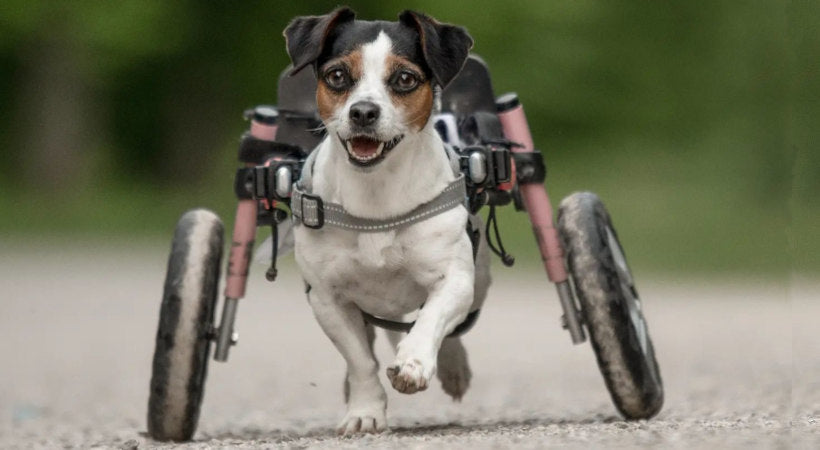Sit Down Dog Wheelchairs

Do Jack Russell Terriers Have Mobility Problems?
Have you ever noticed your Jack Russell limping? Back leg problems are common among Jack Russells. Jack Russell Terriers are incredibly active and known for their high energy level and enthusiastic personality, which can lead to back leg injuries. Bad knees, dislocations, and hip problems are just a few of the mobility issues impacting the Jack Russell Terrier.
3 Reasons Why Your Jack Russell Terrier is Limping
1. Leg Injury

Jack Russells don’t think of themselves as one of the “little guys.” On the contrary, this breed has a big personality and an energy level to match! But unfortunately, their can-do spirit makes them prone to injury, especially from jumping or falling. Here are some common leg injuries that every Jack Russell parent should be aware of:
- Pulled muscles and overstretched tendons
- Sprains
- Fractures and bone breaks
- ACL tears
Jack Russell Terrier's leg injuries range from minor, superficial injuries to full-on trauma. In addition, dogs can react differently to pain. Some signs your dog is injured may include shaking, constant licking, whimpering, limping, holding their paw in the air, or reluctance to move. If your dog exhibits any of these signs, they need immediate veterinary attention.
2. Hip Dysplasia
Hip dysplasia is a genetic condition that causes Jack Russell’s hips to develop improperly. As the dog ages, the joint condition can progress to arthritis and severe joint pain. Jack Russell’s struggling to push up off the ground, limping when walking, or having difficulty standing up after resting may have advanced hip dysplasia. Elbow dysplasia is also common among the Jack Russell breed.
Dogs with bad hips should be kept at a healthy weight and given daily joint supplements to keep the hip lubricated. A dog hip brace may be worn to minimize hip pain and promote continued mobility. If the hip pain has progressed to a point where the dog can not walk unaided, a dog wheelchair may be necessary to help your Jack Russell walk.
3. Knee Problems in Jack Russell Terriers

Like other small breeds, patellar luxation is common among the Jack Russell Terrier. A luxating patella is painful and can cause a Jack Russell to limp. Patellar luxation is when a dog’s kneecap dislocates or slips out of place. When this happens, many little dogs point their back leg behind them to reposition the kneecap and pop it back into place. You may not even realize that your dog is doing this, but if they do - it’s time to visit the vet.
There are different treatment options for a luxating patellar. A conservative approach may include rehab therapy to strengthen the stifle joint and wearing a knee support to support the knee. More extreme measures for chronic patellar luxations can consist of surgery.
How to Help Your Jack Russell When They Limp
Support the Injured Leg
A canine leg injury needs proper joint support to heal and limit the risk of your Jack Russell reinjuring themselves. There are many different types of leg supports; the best one for your dog depends on the injury's severity, the affected joint, and how long their recovery is expected to take.
- Splints - off-the-shelf braces for common leg injuries, available for front and rear legs. A splint is best for short-term use.
- Neoprene Wraps - lightweight wraps that conform around the hock or carpal joint for temporary leg support.
- Hip Support - a soft brace that supports the hip joint, reduces inflammation and relieves hip pain—ideal for mild to moderate hip dysplasia.
Reduce the Pressure on the Leg with a Lifting Harness
When a dog’s leg hurts badly enough to cause limping, your dog is most likely unable to bear its full weight on its back leg. A simple rear lifting harness may be the solution to give your dog a little extra support as the leg heals.
Lifting harnesses slide up your dog’s hind legs to support them underneath their hind end. Look for a rear support harness with adjustable handles. This will help save your back and give you an easy way to walk your dog outside when it’s time to pee or poop. A rear lift harness can also help you safely get your dog into the car or up the stairs.
Jack Russell Wheelchair
For chronic injuries where hind leg support is needed all the time, a Jack Russell wheelchair will offer the most assistance. There are rear dog wheelchairs and four-wheel wheelchairs, depending on the leg injury. A rear-wheel cart will support the back legs, and your dog can continue to walk and use their hind legs. In addition, many pets will incorporate their wheelchair into rehab therapy to rebuild muscle tone and leg strength as they heal. A dog wheelchair with front wheels is best when the front legs are weak and require extra support. Most Jack Russell Terriers will fit into a Small Walkin' Wheels dog wheelchair.








